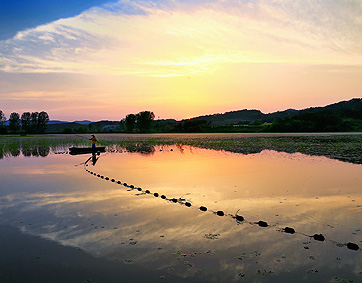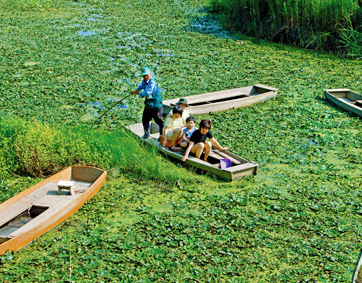Upo Wetland
- CNN’s PICK Rank 03. Darangee Village
- CNN’s PICK Rank 05. Kyeonghwa station
- CNN’s PICK Rank 06. Upo Wetland
- CNN’s PICK Rank 13. Haein Temple
- CNN’s PICK Rank 14. Chungwang Peak
- CNN’s PICK Rank 17. Cherry blossom road
- CNN’s PICK Rank 29. Terraced fields
- CNN’s PICK Rank 34. Royal Azalea Festival
- CNN’s PICK Rank 49. Chokseongnu Pavilion
CNN’s PICK Rank 6.
Upo Wetland Upo Wetland, Korea’s largest natural wetland, preserves the traces of ancient times. Formed around 140,000 years ago, it covers 2,313㎢ and spans Jumae-ri of Daehap-myeon, An-ri of Ibang-myeon, and Daedae-ri and Sejin-ri of Yueo-myeon. It is an ecological treasure trove and home to some 1,500 species of plants and animals.
- It provides a habitat for cattail, iris, reeds, zizania latifolia, eleocharis kuroguwai, hornwort, arrowhead, and lotus. The trees are half immersed in wetland, creating a primeval mood.
Upo Wetland was designated as an ecologically protected zone (Notification No. 1977-66, Ministry of Environment) among the ecological preservation areas on July 26, 1998, and registered as a Ramsar Wetland on March 2, 1998. Shortly thereafter, it was designated as a wetland protection area by the Ministry of Environment, on February 8, 1999, and some years later as a natural protection area, on January 13, 2011 (Natural Monument No. 524). -
In February of the same year, it was selected as one of Korea’s eight best tourist sites by the Ministry of Culture, Sports and Tourism.
Located in and around Upo Wetland are the Upo Wetland Ecological Center, which features slides of the animals and plants that inhabit the wetland, observatory cameras, the most advanced human body-responsive images and 3D images, and four videos about Upo Wetland; a natural botanical park where visitors can experience the four seasons of Upo Wetland; an observatory deck; and four tour paths. Other exciting programs such as riding an ox cart are available.
Along the 8.7㎞-long exploration course,
which takes about 4-5 hours to walk, visitors can explore the core features of Upo Wetland including the ecological center, Daedae Bank, Somok Parking Lot, Mokpo Dyke, Dinosaur Fossil Site, and Observatory Deck. This course is constructed in a cyclical form, returning to the starting point, either starting from the ecological center or Somok Parking Lot.


